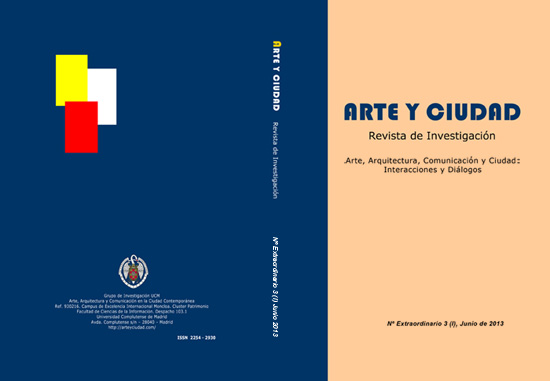José Luis Sánchez y Luis Cubillo: entre el Románico y la Vanguardia
DOI:
https://doi.org/10.22530/ayc.2013.N3.1.313Resumen
La presente comunicación tiene su origen en una entrevista realizada al escultor José Luis Sánchez el 22 de diciembre de 2011, para conocer su aportación a la arquitectura religiosa de Luis Cubillo de Arteaga. El artista, que trabajó con más de un centenar de arquitectos, se convirtió en uno de los referentes del nuevo arte sacro, junto a Pablo Serrano, José Luis Alonso Coomonte o Venancio Blanco. Colaborador habitual de José Luis Fernández del Amo, compartía con él su visión integradora de las artes, frente a la primacía dada por Miguel Fisac a la arquitectura sobre la escultura y la pintura. Las tres ocasiones en que trabajó con Cubillo, todas ellas en templos madrileños, permiten varias consideraciones sobre su obra, desde el citado diálogo con la arquitectura hasta las fuentes de inspiración de sus esculturas. Su primera colaboración se dio en la iglesia del Poblado Dirigido de Canillas (1962). La escultura del Crucificado que preside el templo remite al arte románico y su esencialización de la forma. Así mismo, se constata que la radical estética industrial del edificio de Cubillo necesitaba algo distinto de la imaginería de Olot dominante. Las obras realizadas en las parroquias de San Fernando (1973) y Jesús de Nazaret (1974), recogen con fidelidad las indicaciones del Concilio Vaticano II sobre el número de imágenes en el templo, así como la jerarquía que se debía establecer entre ellas. Especialmente destacables son los trabajos realizados en la primera. En ella, además de las imágenes, José Luis Sánchez diseñó todo el mobiliario litúrgico, desde los altares hasta los candelabros. La integración total con la arquitectura y el acertado manejo de materiales y texturas convierten su trabajo en este edificio en un buen exponente del arte socializante que el artista persiguió a lo largo de su obra. Palabras clave: Románico, estética industrial, arte socializante, imágenes. José Luis Sanchez and Luis Cubillo: between the romanesque and the avant-garde Abstract This communication comes from an interview done on December 22, 2011 to the sculptor José Luis Sánchez, to know his contribution to the religious architecture of Luis Cubillo de Arteaga. The artist, who worked with over a hundred architects, became one of the leaders of the new religious art, with Pablo Serrano, Jose Luis Alonso Coomonte or Venancio Blanco. Usual collaborator of José Luis Fernández del Amo, both them shared an inclusive vision of the arts, in opposition to the primacy given by Miguel Fisac to architecture. The three times he collaborated with Cubillo, all in churches in Madrid, allow several considerations about his work, from said dialogue with the architecture, to the sources of inspiration for his sculptures. Their first collaboration was in the church of Canillas (1962). The sculpture of the Crucified who chairs the temple refers to Romanesque art and its essentialization of the form. It is also noted that the radical industrial aesthetic of Cubillo’s building needed something different to the dominant imagery of Olot. The works in the parishes of San Fernando (1973) and Jesus of Nazareth (1974), are respectfull with the indications of Vatican II about the number of images in the temple, and the hierarchy that should be established between them. Especially remarkable is the work done in the first one. In it, in addition to the images, Jose Luis Sanchez designed the entire liturgical furniture, from the altar to the chandeliers. Full integration with the architecture and the successful handling of materials and textures became his work in a good exponent of sociali-sing art that the artist pursued throughout his work. Key words: Romanesque, industrial aesthetic, socialising art, images.Descargas
Publicado
2013-06-01
Cómo citar
José Luis Sánchez y Luis Cubillo: entre el Románico y la Vanguardia. (2013). ARTE Y CIUDAD. Revista De Investigación, (3.1). https://doi.org/10.22530/ayc.2013.N3.1.313











